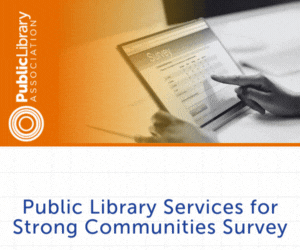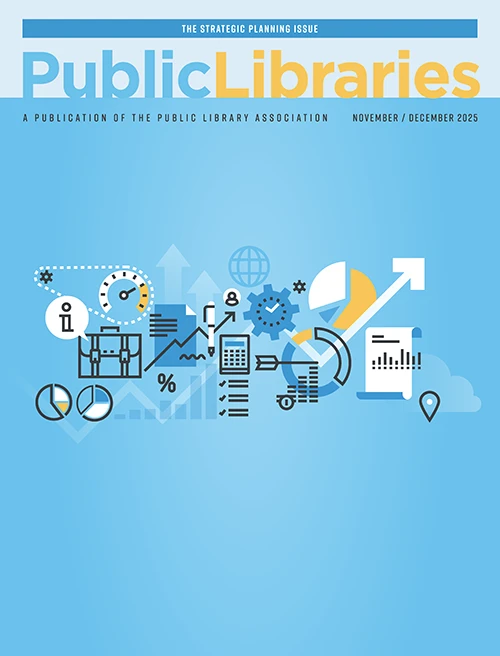Using GIS to Assess Public Libraries
About the Author
DILNAVAZ MIRZA SHARMA is Survey and Report Coordinator in the Office of Research, Planning, and Assessment at Meredith College, Raleigh
(NC). Contact Dilnavaz at sharmadi@meredith.edu. Dilnavaz is currently reading Vanity Fair by William Makepeace Thackeray.
This article first appeared in the NOVEMBER/DECEMBER 2015 issue of Public Libraries.
Simply put, a Geographic Information System (GIS) is a tool for organizing data so that it can be displayed and analyzed based on its geospatial characteristics. Using GIS allows users to combine multiple data sets in order to suss out connections in the subject matter that might not necessarily have been fully apparent without the added element of geographic references.
GIS is a versatile research tool that allows for an additional perspective or contextualization of a dataset based on its relationship to its physical environment. It also enables the user to visualize large quantities of disparate data and relate features of one dataset to those of another within the familiar structures of a map.
GIS and Public Libraries
GIS in public libraries has been used primarily to assess facilities usage and the impact of services in the community. Offering GIS services to patrons is still not as widespread in public libraries as it is in academic and map libraries. A 2014 survey of 115 member libraries, conducted by the Association of Research Libraries (ARL), found that 100 percent of the 54 institutions responding to the survey provided GIS and mapping services to its users.1 I failed to turn up a similarly comprehensive survey of GIS offerings in public libraries.
This is indicative of the public library’s view of GIS as an assessment tool rather than an area of service enhancement. Public libraries, accountable to a political entity by default, have embraced GIS as a tool for evaluating usage, collection development, and community impact by capturing GIS data to provide evidence of the library’s function in the community serviced.
GIS: An Assessment Tool
The all too familiar budget constraints leave public library administrators with little room for error, and under these charged circumstances GIS provides strong data to corroborate on-the-ground observations. As a result, GIS is now an integral decision support tool that library managers resort to when planning strategically for the future. Using GIS data, library personnel can fully understand the characteristics of the populations they serve and in turn develop facilities, collections, programs, and delivery points that align closely with the needs of the constituents.
When the Topeka and Shawnee County (KS) Public Library (TSCPL) began work on its ten-year strategic plan in 2008, they used Tapestry (a data analysis tool from ESRI) to develop a demographic, socioeconomic, and cultural profile of the multiple population groups served by the library system.2 Tapestry allows a user to segment or classify U.S. population by zip code into 65 distinct categories.
Tapestry provides a comprehensive profile of America at the neighborhood level by mapping beyond the familiar demographic information, to present a portrait of the country based on accumulated data points generated by our daily lifestyle and consumer choices. When studied collectively, this collection of data allows GIS researchers to create an accurate and revelatory consumer profile of a given area.
In the past, such information would have been costly. GIS platforms such as Tapestry have streamlined market segment research and reduced the effort and cost associated with it. In short, Tapestry provided TSCPL with a granular look at the population it served, as well as trend analysis that enabled library staff to develop a growth strategy that was commensurate with community needs.
In-Library Usage Data
While TSCPL used GIS data to conduct a quintessential needs analysis in advance of a planning cycle, GIS can also be utilized to provide a more extensive view of in-house library use. Public libraries have traditionally relied on reference and circulation numbers to substantiate budgetary needs. While a library’s checkout rates, entry/exit counts, and reference-use statistics give administrators a balanced view of the library’s usage, GIS can help fill in the details to create a more complete account of the ways in which a public library fulfills the educational and social needs of its community.
For example, GIS can be used to provide a quantitative measure of the social activity taking place within the library. In an article about using GIS to map in-library use, Lauren Mandel gives an example workflow chart for mapping a library’s social activity.3 Mandel suggests using Microsoft Office suite in conjunction with MapWindow, an open-source GIS tool, to overlay the floor plan of a library building with data points that capture
patrons’ use of the space.
In order to create such a map, some level of advance planning would be required. By mapping in-library use data, administrators can identify building use-cycles based on time of day or seasons of the year. In turn, having use cycle information will help libraries anticipate and leverage heavy traffic periods to plan programming or showcase new acquisitions.
Jingfeng Xia, an expert in library space management, employed GIS to compare the checkout rates of items housed on shelving of different heights in a library.4 He mapped the circulation of library material relative to its placement on the library’s shelves. A map of where a library’s checked-out materials are housed allows management to follow the circulation trail and identify problems in signage, access, or visibility that might be causing an imbalanced use of the library’s collections.
Collection Development
Having a solid idea of your users’ demographic profile and usage habits is futile if you don’t evaluate your collections to fit closely with their information preferences and needs. GIS helps you identify potential growth areas in collections based on increased usage over time. Emerging trends that might have gone unnoticed in the day-to-day bustle of running a library are magnified and hard to ignore when depicted as a concentrated collection of dots on a map, each one representing a unique or cluster of unique library transactions.
Naturally, collection development is enhanced with the application of GIS tools. Elizabeth LaRue offers an excellent case study of how GIS maps were
used to identify public library locations in Chicago that would be ideal for providing consumer health information materials to underserved populations.5 Based on this study, the author was able to make recommendations for the installation of new collections in some libraries and suggest enhancements to existing collections.
LaRue built on past Internet search term studies that identified women in their forties as the most likely group to search and utilize health information online. By mapping the city based on its population’s demographic profile and citizens’ access to public libraries, LaRue pinpointed neighborhoods that had a larger distribution of women approaching middle age. The racial makeup of the various neighborhoods further enhanced her ability to recommend culturally sensitive and appropriate material for purchase by local public libraries.
LaRue used ESRI GIS products and U.S. Census Bureau information to conduct a thorough survey of a city’s information landscape. She warns of a steep learning curve when it comes to using ESRI’s ArcView and ArcGIS to accomplish research goals. From personal experience, I can assure you they get easier with practice.
In addition to ESRI GIS products, which are proprietary, there are a host of opensource GIS tools that are available online for free. The American Library Association has an excellent resource guide for opensource GIS tools published by its Map and Geography Round Table.6
GIS is a new tool available to librarians grappling with the question of who needs our services the most, what we should offer to maximize our impact in our communities, and where our limited resources are best spent to address the changing needs of our users. These questions and more can be answered with GIS data that is empirical, quantitative, and convincing, giving us the tools we need to better advocate for our patrons’ needs.
References
- Ann L. Holstein, “Geographic Information and Technologies in Academic Research Libraries: An ARL Survey of Services and Support.” Information Technology and Libraries 34.1 (2015), accessed Dec. 16, 2015.
- Jim Baumann, “Targeting Local Library Patrons: Tapestry Weaves Common Characteristics into Community Profiles,” ArcUser Online (2012), accessed Dec. 9, 2015.
- Lauren H. Mandel, “Geographic Information Systems: Tools for Displaying In-Library Use Data,” Information Technology and Libraries 29, no. 1 (March 2010), accessed Dec. 9, 2015.
- Jingfeng Xia, “Library Space Management: A GIS Proposal,” Library Hi Tech 22, no. 4 (2004), accessed Dec. 9, 2015.
- Elizabeth M. LaRue, “Using GIS to Establish a Public Library Consumer Health Collection,” Biomedical Digital Libraries 1, no. 3 (Nov. 2004), accessed Dec. 9, 2015.
- Available at www.ala.org/magirt/sites/ala.org.magirt/files/content/publicationsab/GIS_Program_Top_5_Re.pdf.
Tags: assessment, community assessment, Geographic Information System, GIS












